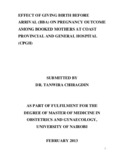| dc.description.abstract | Background: Birth before arrival (BBA) at hospital delivery unit is still common even in modern obstetric practice and it carries significant adverse maternal and neonatal outcomes all over the world but more so in low income countries like Kenya. Some of the risk factors associated with BBA are lack of or poor quality antenatal care, lack of or
poor infrastructure, insecurity, adverse weather conditions, socio-cultural barriers for women to seek health care, unaffordable health care and inaccessible health facilities. . Antenatal care, childbirth and delivery are essential and should be affordable and accessible to all mothers. Three of the eight Millennium Development Goals (MDGs) address the concerns arising in birth before arrival to hospital. These are MDG numbers
3, 4 and 5 which state that countries should promote gender equality and empower women, reduce child mortality and improve maternal health respectively
Objective: To determine the effect of birth before arrival (BBA) on pregnancy outcomes at Coast Provincial and General Hospital.
Setting: Coast Provincial and General Hospital (CPGH) maternity unit.
Study Design: A 1:1 matched case-control study
Study Population: Postnatal mothers (BBA and hospital delivered) admitted to CPGH
maternity unit
Sample size: A sample size of 156 was used consisting of 78 cases and 78 controls matched for age (+/- 5years) and parity (para 1, multipara and grand multipara).
Methodology: Cases were recruited sequentially until the desired size of case population was reached. Cases comprised of mothers who delivered outside CPGH maternity unit but had planned a hospital delivery and were admitted after delivery. For each case recruited, one control matched for age and parity was selected randomly using balloting method. Controls comprised of mothers who had booked/planned hospital delivery and delivered at CPGH labour ward within 24 hours of case recruitment. Upon recruitment, both cases and controls were assessed in terms of their social demographic characteristics, risk factors and maternal and neonatal outcomes. Data was collected using an interviewer-administered questionnaire. The questionnaire was structured and
pre-coded for ease of data collection and uniformity. Data analysis was done using Epi info and SPSS software version 17.0 for descriptive statistics and measures of association and correlation. Data was then presented in tables.
Results: The mean age of the study participants was 25.2, with a range of between 24 to
27 years. Majority of the participants were married (87.2%), had at least primary school level of education (57.1%), were housewives (56.4%) and were para 1 (53.8%). Area of residence was found to be a significant factor in having a BBA (OR 11. 5; 95% CI 5.2-
25.4). No significant association was found between BBA and maternal level of education, marital status and occupation. Non-satisfactory antenatal care (p<0.001) and lack of birth and emergency preparedness (p<0.001) during the antenatal period significantly influenced the risk of having BBA. BBA mothers were more at risk of developing postpartum complications compared with mothers who had a hospital delivery (AOR 17.0 and p-value <0.001). The complications experienced by the BBA
mothers are postpartum haemorrhage (29.5%), puerperal sepsis (24.4%) and birth injuries (20.5%). There were significant adverse neonatal outcomes amongst the BBA babies, warranting NBU admission, as opposed to those babies who were delivered in hospital (AOR 8.3; 95% CI 4.4-15.1 and p-value <0.001). The indications for admission to the NBU were (in order of frequency): prematurity (40.7%), respiratory distress (25.3%), birth asphyxia (13.2%) and neonatal sepsis (2.2%).
Conclusion and recommendation: Birth before arrival to hospital delivery unit is associated with adverse maternal and neonatal outcomes. The risk factors associated with BBA are preterm delivery, short duration of labour and residence out of Mombasa Island. Lack of or inadequate birth and emergency preparedness during antenatal care also contribute significantly to out of hospital deliveries.
It is thus prudent to put emphasis and counsel the mothers on birth and emergency preparedness during antenatal care in each visit in order to avert this situation. Improvement of infrastructure to avoid delays in reaching the health facilities for delivery is necessary. Also, new health facilities offering maternity services should be built in Mombasa mainland for easy accessibility by the mothers in labour. | en |
| dc.description.department | a
Department of Psychiatry, University of Nairobi, ; bDepartment of Mental Health, School of Medicine,
Moi University, Eldoret, Kenya | |

